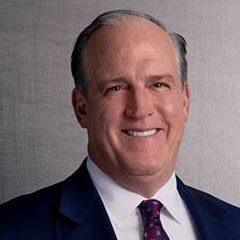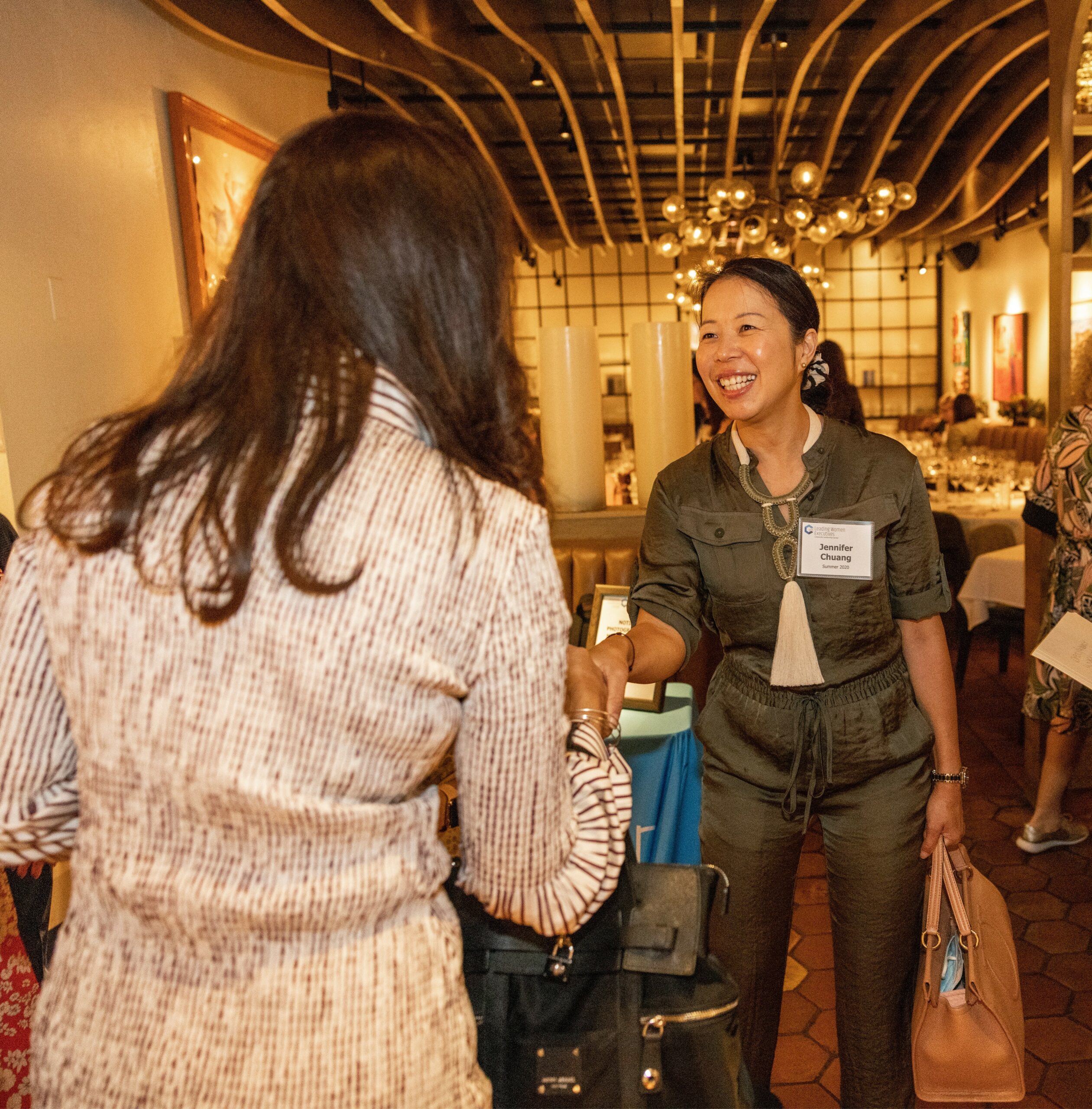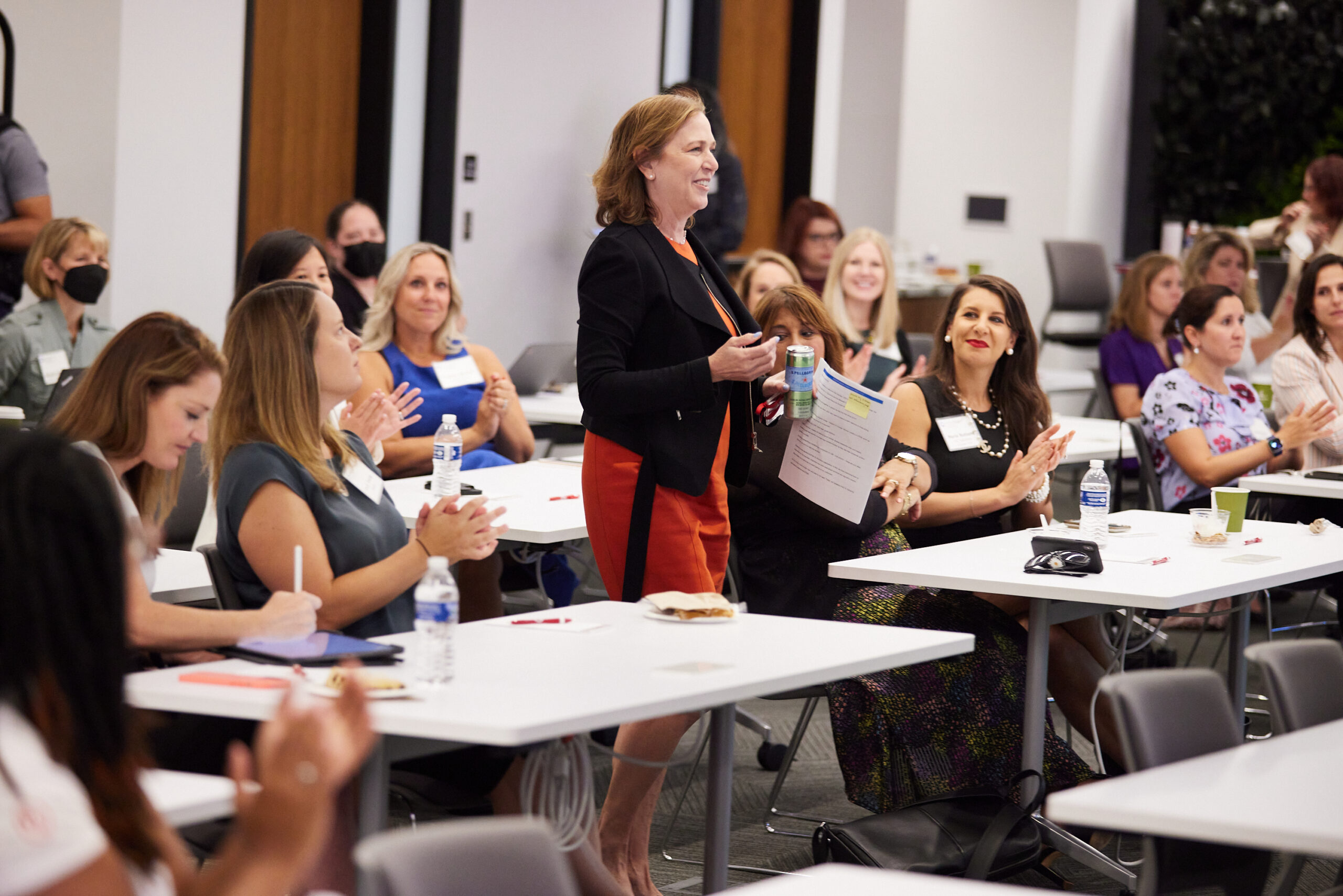
The following themes, ideas and recommendations were generated during the Leading Women Executives workshop, held on August 3rd, 2021, to address the topics of:
- Retaining and reengaging talent;
- Rebuilding culture; and
- Reskilling employees.
Guest speakers featured Mary Bilbrey, Global CHRO, JLL and 2019 CEO Perspectives Fellow; Carrie Blair, Executive Vice President & CHRO at Allstate; and Diane Earll, Senior Vice President, USG Corporation & President, Ceilings; 2020 CEO Perspectives Fellow and 2012 Leading Women Executives Fellow.

RETAINING & REENGAGING TALENT:
The “war on talent” has changed significantly because of the pandemic. Many workers, particularly women, are opting to stay out of the labor market or scale back their careers. Additionally, drops in engagement scores and high employee demand for different working environments are requiring companies to be more flexible to avoid the “turnover tsunami”. As a result, companies need to be very intentional about their focus on retention and engagement, building it into their practices and processes; identifying metrics by which they can chart their progress; and developing training to support their objectives.
- Leverage the voice of employees as a source of ideas and information
- Use people surveys and Employee Resource Groups (ERGs) to test concepts and get the pulse of the organization.
- Provide programming to bring people together and make large companies feel smaller.
- Examples: Working Parents ERG developed a “Bring Your Child to Virtual Work Day”; Black ERG focused on Juneteenth as national holiday; A mentorship program was developed for an Asian ERG.
- Focus on diversity, inclusion and belonging
- Remove geographic limitations for work to attract more diverse candidates.
- Modify hiring requirements to “broaden the aperture” and attract candidates that might not otherwise be considered (e.g., eliminate requirement for a graduate degree).
- Post positions for everyone to see.
- Improve interviewing skills and practices to account for cultural, demographic differences.
- Help employees to build and expand their networks
- Encourage employees to think about the “Circle of Influence” concept and network with purpose (i.e., who do they have relationships with already and map their networks to branch out further and gain more sponsorship).
- “Pay it forward” by helping employees to make connections.
- Younger talent: Schedule opportunities for them to connect with people who can help in their careers.
- New hires: Set up buddy programs; virtual coffees; and virtual lunches with executives as part of onboarding.
- ERGs: Encourage memberships as a way for employees to make social connections.
- Remote employees: Schedule virtual coffees; set up virtual peer groups.
- Create flexibility and choice in how and where employees work
- Set guidelines that embrace flexibility consistently across the organization so employees do not feel like there are “haves” and “have nots”.
- Provide employees who are returning to the office a payment (e.g., $1000) to ease the transition (e.g., childcare expenses, transportation, etc.).
- Provide remote employees with a “connectivity allowance” to allow them to create a productive and successful work environment at home (furniture, supplies and technology); paid via payroll rather than reimbursements.
- Set guidelines that embrace flexibility consistently across the organization so employees do not feel like there are “haves” and “have nots”.
- Invest in technology
- Find resources for employees to communicate and collaborate better/more efficiently.
- Use tools like My Analytics to help employees track how they are spending their time and make choices based on this information.
- Give people “space” to promote mental/physical health
- End meetings 5 minutes early to allow time for a break.
- Implement Summer Fridays/”No-Meeting Friday Afternoons”.
- Change the default on employees’ Outlook calendars to start the workday an hour later.
- Block the same hour on everyone’s calendars every day as “meeting free” time.
- Provide employees with health and wellness apps that provide virtual courses (fitness, meditation, yoga, nutrition, etc.); Link to community giving programs – company’s donation grows as employees commit to health and wellness goals.
“Companies are hiring from a wider pool of talent cutting across the different sectors, which is really putting pressure on organizations to rethink their offerings.” – Mary Bilbrey
REBUILDING CULTURE:
Strong culture drives employee engagement and retention. Finding ways to facilitate togetherness and create connections among in-person and remote employees is more important than ever. It has been especially challenging for employees who have joined the company or changed positions while working remotely, as they need assistance navigating the company and creating connections.
- Articulate the company’s shared purpose
- Provide clear guidance in what the company is looking for in employees, actions, collaboration, and key behaviors.
- Use the shared purpose as the “North Star” for decisions, goals, and priorities.
- Hold regular town hall meetings to share successes, challenges, and priorities.
- Create a culture of recognition
- Give and receive recognition at all levels of the company to honor employees for their contributions and accomplishments.
- Build ways to connect, check in with one another
- Assign connections (e.g., once month employees are given the name of someone in the company they wouldn’t otherwise interact with; encourage them to have virtual coffee or meet for lunch)
- Develop social events (e.g., team trivia, sports groups or book clubs, ‘Fun Friday’ activities such as cooking, meeting everyone’s pet, etc.)
- Define rules of engagement for virtual connections (e.g., cameras on, break the ice conversations at the start of a meeting, etc.).
- Level the playing field for everyone
- New Hires:
- Create a “playbook” for employees on how to engage with key people in the company so that they can be successful (e.g., who tends to work in the office, who is best reached by text, etc.)
- Set up virtual meetings with executives and other key employees for new hires to meet as part of their onboarding process.
- Teams: Work to ensure that no one feels “left out” if they are working remotely.
- Replace traditional whiteboards with e-whiteboards for Zoom participants.
- Require that everyone participating in the meeting joins by Zoom, regardless of whether they are working in person or remotely.
- Find technology that works to bring people together effectively and train employees how to use it.
- New Hires:
“A strong culture strengthens the company and allows us to attract and drive employee engagement and retention.” – Diane Earll
RESKILLING EMPLOYEES:
Studies show that 50% of all employees globally will need to be reskilled by 2025. Technology capabilities are now a requirement in every field – regardless of role – forcing companies to rapidly shift their thinking about how they can both attract and retain new talent, as well as upskill and reskill current talent. A critical focus for organizations is ensuring that managers not only have the required “hard skills” (e.g., analytics, technology, etc.), but also have the “soft skills” (e.g., agility, creativity, resiliency, etc.) to manage and lead teams in this new environment.
- Upskill leaders to manage diverse teams and work modes
- Move away from the mentality of “work has to be done in the office”. If leaders’ thinking does not evolve, HR teams must be prepared to address the issue to avoid employee attrition.
- Find technology that works for everyone to collaborate and innovate.
- Belongify.com – a model to create belonging in an organization; geared to leaders for developing and advancing hybrid and remote teams.
- Ensure teams are diverse so leaders can learn from and manage employees in a variety of settings.
- Require managers and leaders to connect with their teams/employees regularly.
- Establish metrics to demonstrate productivity and business results.
- Book club (Doing Agile Right) was turned into a game of ‘Truth or Dare’; participants had to either apply what they were learning (Dare) or share a vulnerability about themselves as a leader (Truth).
- Move away from the mentality of “work has to be done in the office”. If leaders’ thinking does not evolve, HR teams must be prepared to address the issue to avoid employee attrition.
- Create a culture of learning
- Allow employees to proactively identify what skills they want to develop.
- Hold a “hackathon” to allow employees to learn about and practice new skills.
- Focus on soft skills too
- The top 5 skills recently identified by the World Economic Forum are: analytical thinking and innovation; active learning and learning strategies; complex problem-solving; critical thinking and analysis; and creativity, originality and initiative. Few current job openings identify these skills as requirements.
- Agility, change-ready and resiliency are other critical skills that must be cultivated.
- Foster learning from peers
- Set up employees in cohorts to give them a place to connect with others and learn/apply hard and soft skills. “Peer cohorts are the best teachers of people management.”
- Provide employees with ways to meet others to recreate the “run-ins” that naturally occur when everyone is working in the office.
- Create monthly pairing assignments; meet for virtual coffee to learn about someone who works in a different part of the company.
- Develop ways to bring in new skills and capabilities
- Create apprenticeship programs (examples: IBM and AON); providing tuition support (working with academic institutions to lower the cost of their programs), rather than tuition assistance (helping participants to defray the cost of tuition) fosters better retention and drives down overall costs.
- Adapt job descriptions to access a larger pool of candidates (e.g., dropping GPA requirements, eliminating graduate degree requirements).
- Design workforce development programs to help train and upskill communities to be ready for careers in an industry.
- Develop training programs for employees to grow talent in-house (e.g., three-year path to project manager).
“We have to create a real culture of learning and make it available so our employees can proactively identify what skills they want to develop.” – Carrie Blair

